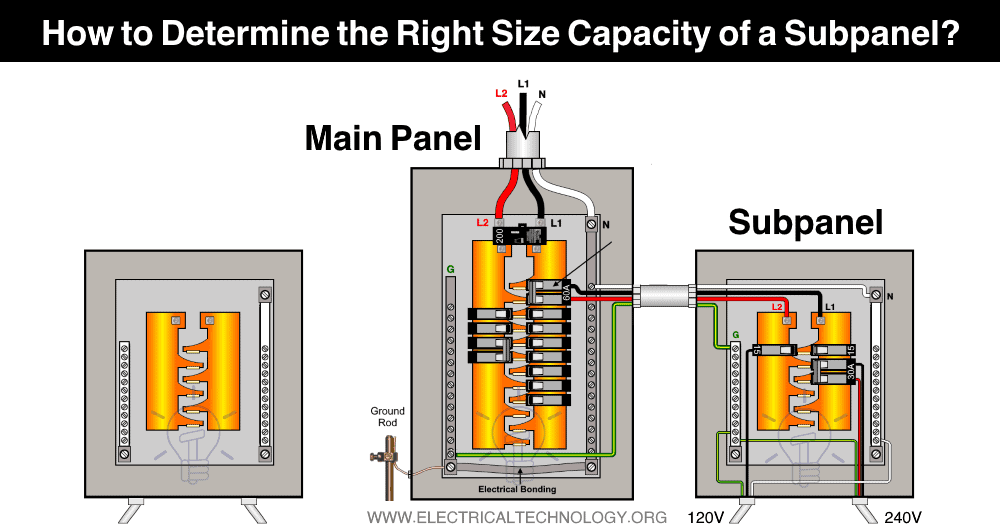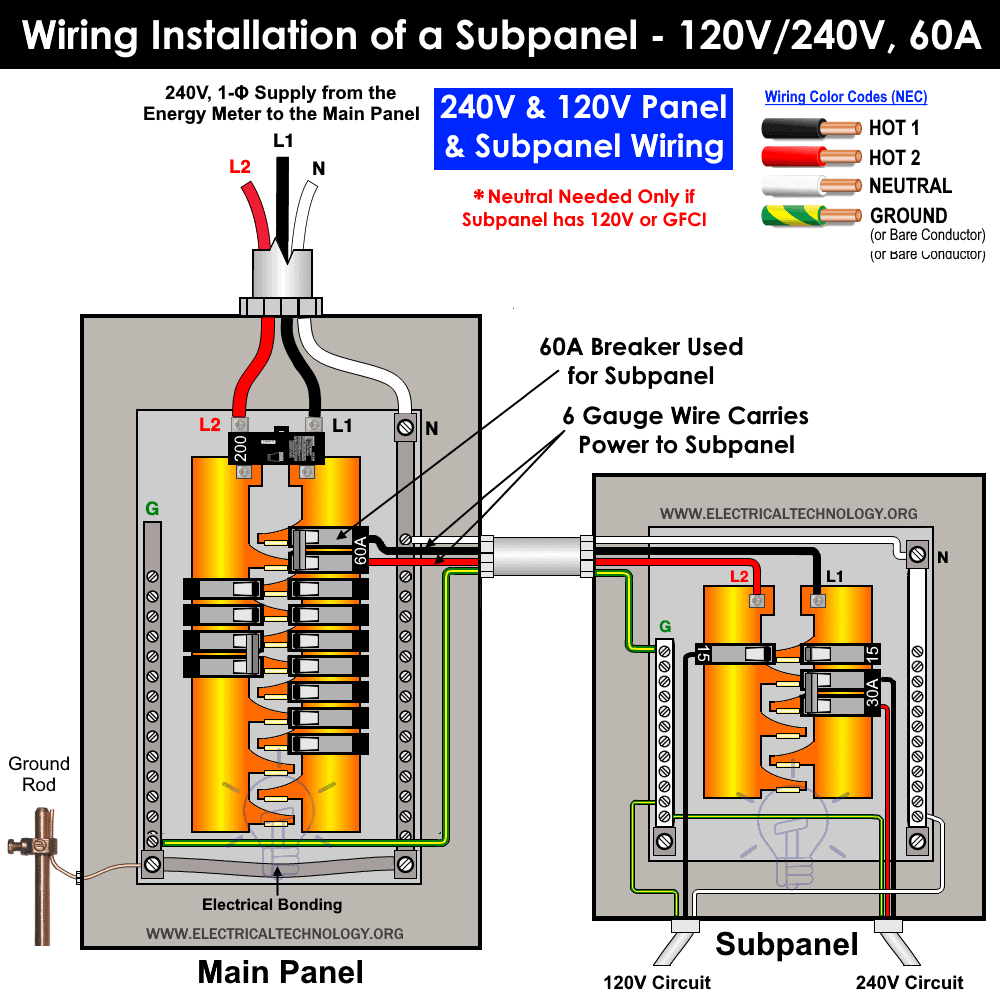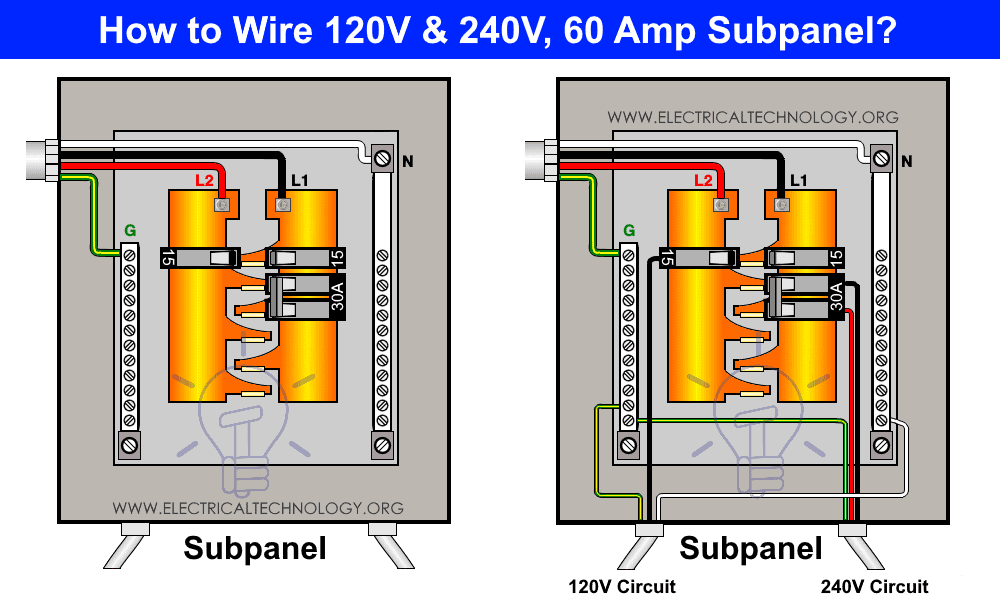How to Determine the Right Size Capacity of a Subpanel?
Sizing the Suitable Capacity of a Subpanel or Main Lug
A subpanel or main lug (aka Remote Panel in NEC) is a smaller service panel installed downstream from the main breaker box or load center in the home. Generally, the subpanel is needed to be installed in a separate section of premises e.g. barn, garage, workshop or any other part of building for specific applications.
To wire a subpanel or main lug, It is very important to calculate the suitable size of subpanel for specific load points where the rated capacity of subpanel should not exceed the peak amount of power used by electrical appliances and any other connected load points to the subpanel e.g. outlets and receptacles.
The subpanel is wired through a feeder to the main panel via two hot wires (Hot 1 and Hot 2) using two poles 240V breaker and a Ground wire. Keep in mind that the Neutral in the subpanel is only needed when there are 120V circuits, GFCI/AFCI outlets and breakers including 240V circuits. Note that bonding in the subpanel is not required as the ground and neutral is already grounded in the main service panel.
The purpose of the main panel and subpanel is the same i.e. both of them control and protect the wired circuits against electric faults, electric shocks and surges. Mainly, the subpanel is used to provide additional circuit spaces and separate control and safety to the circuits.
Related Posts:
- How to Size a Load Center, Panelboard and Distribution Board?
- How to Determine the Number of Circuit Breakers in a Panelboard?
Sizing a Subpanel
Let’s follow the basic example given below to know how to find the appropriate size of subpanel capacity and circuit spaces?
Example:
Suppose, we have to install a subpanel for three circuits having the following wattage ratings.
- General Lighting = 120V, 1500 W
- 1 x Outlets : 120V x 12A = 1440 W
- 1 x Electric heater: 240V x 23.3A = 5600 W
Solution:
Normally, general lighting and other small appliances are connected to 15A or 20A, 120V single pole breakers. While the large appliances like air-conditioner, water heater, electric range, clothes dryer are connected to 20A-50A, 240V double pole breaker.
Calculating the Wattage
To find the rating of the subpanel, we have to tally the total wattage of the appliances which has to be connected to the subpanel or main lug.
1500 W + 1440 W + 5600 W = 8540 W
Calculating the Amperes
Now, we can easily find the amperage rating of the appliances. Since the voltage levels are 120V and 240V (US), we have to choose the highest level of voltage i.e. 240V.
I = P / V
Where:
Putting the values:
I = 8540 W / 240V
I = 35.6A
Safety Factor
For proper and smooth operation of the circuit breakers in high temperature, we have to multiply the safety factor of 125% (1.25) to the total calculated amperage capacity.
1.25 x 35.5A = 44.48A
Future Expansion
To be on the safe side, it is recommended to add 20% of additional amperage to the calculated value. This way, we may add more circuit(s) in the future if needed.
20% x 44.48A = 53.38A
Based on the estimated value, the next available and suitable size main switch breaker for the subpanel is 60A.
The right size of feeder wire for the 60A subpanel is 6 gauge. If the distance is more than 140 feet (42 meters), a 4 gauge wire should be used instead of 6 gauge wire.
Related Posts:
- How to Wire a Subpanel? Main Lug Installation for 120V/240V
- How to Find the Proper Size of Circuit Breaker? Breaker Calculator & Examples
Subpanel Space and Circuits
There are a total 3 breakers (1 x Single Pole & 1 x Tow-Poles) are needed in the given example i.e. total 4 spaces will be occupied by these breakers. In this case, the minimum 4-Space, 8 Circuits main lug is needed. With the future expansion load, it is recommended to select the 6 Space, 12 Circuits subpanel for 60A designed for 8.5kW load points.
Related Posts:
- How to Find The Suitable Size of Cable & Wire ? – Solved Examples
- How to Find Voltage & Ampere Rating of Switch, Plug, Outlet & Receptacle
- How to Wire a Single Element Water Heater and Thermostat?
- Wire & Cable Size Calculator in AWG
- Electrical Wire & Cable Size Calculator (Copper & Aluminum)
- How to Wire Single-Phase, 230V Consumer Unit with RCD? IEC, UK & EU
- How to Wire a Garage Consumer Unit?
- How to Wire 120V & 240V Main Panel? Breaker Box Installation
- How to Wire 277V & 480V, 1-Phase & 3-Phase, Commercial Main Service Panel?









